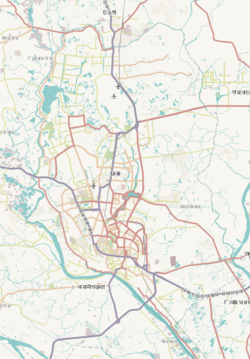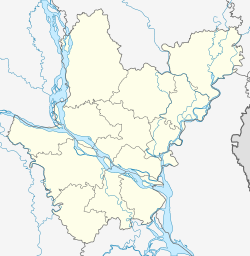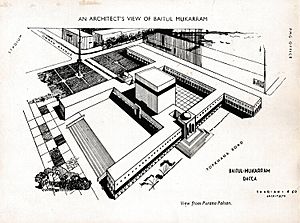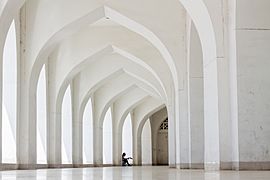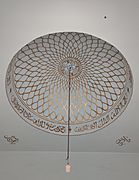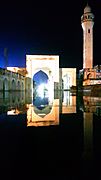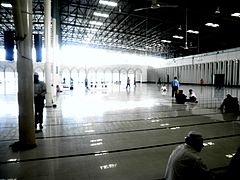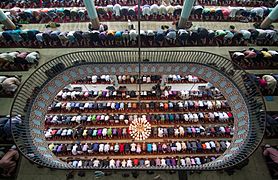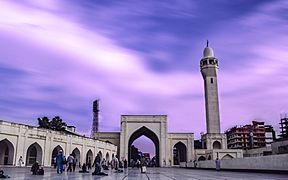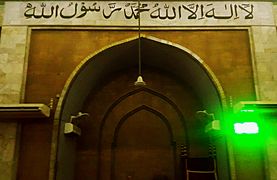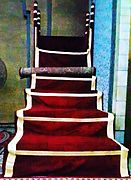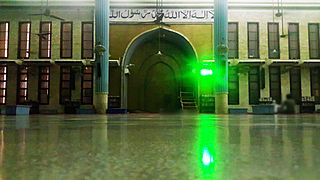Baitul Mukarram National Mosque facts for kids
Quick facts for kids Baitul Mukarram National Mosque |
|
|---|---|
|
বায়তুল মোকাররম জাতীয় মসজিদ
|
|
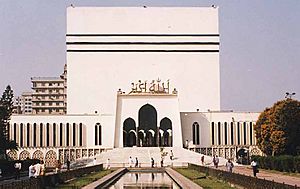
|
|
| Religion | |
| Affiliation | Islam |
| Sect | Sunni Islam |
| District | Dhaka District |
| Ownership | Government of Bangladesh |
| Year consecrated | 1959 |
| Status | Active |
| Location | |
| Location | Topkhana Road, Dhaka |
| Country | Bangladesh |
| Administration | Ministry of Religious Affairs |
| Architecture | |
| Architect(s) | Abdulhusein M. Thariani |
| Architectural type | Neo-islamic |
| Architectural style | Islamic Architecture |
| Founder | Government of East Pakistan |
| Funded by | Abdul Latif Ibrahim Bhawani |
| General contractor | Thariani & Co. |
| Groundbreaking | 27 January 1960 |
| Completed | 1968 |
| Specifications | |
| Capacity | 42,000+ |
| Height (max) | 99 feet |
Baitul Mukarram, also known as Baytul Mukarrom, is the National Mosque of Bangladesh. Its name means "The Holy House" in Arabic. This large mosque is located in the center of Dhaka, the capital city of Bangladesh. It was finished in 1968 and can hold over 42,000 people for prayers.
Contents
History of Baitul Mukarram Mosque
The idea for Baitul Mukarram Mosque began in 1959. A businessman named Abdul Latif Ibrahim Bawani wanted to build a grand mosque in Dhaka. He met with important people, including Major General Umrao Khan, who was a military leader at the time. They all agreed to help make this big project happen.
Later that year, a special committee was formed for the mosque. They chose a large piece of land between old and new Dhaka. This area used to have a big pond called 'Paltan pond'. The pond was filled in to make space for the mosque.
Construction officially started on January 27, 1960. The president of Pakistan at that time, Ayub Khan, began the work. The first prayers were held on Friday, January 25, 1963. The mosque was fully completed in 1968. In 1975, the government of Bangladesh took over managing the mosque.
The mosque complex was designed by architect Abdulhusein M. Thariani. His plan included not just the prayer hall, but also shops, offices, libraries, and parking areas. This was a new idea for a mosque at the time. Unlike many traditional mosques, the main prayer hall of Baitul Mukarram does not have a large dome on its roof. This made it a very unique building. In 2008, the mosque was made even bigger with help from the Saudi government.
Architecture and Design
The Baitul Mukarram Mosque has a modern look, but it also uses ideas from older Mughal architecture. Mughal style was very popular in the Indian subcontinent for a long time. The mosque's main building is shaped like a large cube. This design was inspired by the Kaaba in Mecca, which is a very important building in Islam. This cube shape makes Baitul Mukarram stand out from other mosques in Bangladesh.
Outside the Mosque
The mosque sits on a very tall platform. The main building has eight stories and is 99 feet (about 30 meters) high from the ground. The main entrance is on the eastern side. There is a large open area on the east, which is about 29,000 square feet. On the north and south sides of this area, there are special places for ablution (Wudu). Ablution is the washing ritual Muslims perform before praying.
Even though the main building doesn't have a big dome, there are two smaller domed entrances. One is on the south side, and the other is on the north. These entrances have three arches, with the middle one being the largest.
Inside the Mosque
Inside the Baitul Mukarram National Mosque, there are two open courtyards called patios. These patios help bring lots of light and fresh air into the prayer hall. The special prayer area, called the mihrab, is rectangular instead of being curved. The mosque's design avoids too much decoration. This simple style is common in modern architecture.
The Mosque Garden
The garden at Baitul Mukarram is designed in a style similar to Mughal gardens. These gardens are known for their beautiful layouts. However, this garden does not have the traditional "Char-Bagh" system, which usually divides the garden into four parts. This is probably because there wasn't enough space for such a large garden.
Khatibs of Baitul Mukarram National Mosque
A Khatib is a religious leader who gives the sermon (a speech) during Friday prayers. Here is a list of the Khatibs who have served at Baitul Mukarram National Mosque:
| Serial No. | Name | Term | Notes |
| 1 | Abdur Rahman Kashgari (1912–1971) | 1963–1971 | |
| 2 | Usman Madani | 1971 | Acting |
| 3 | Amimul Ehsan Barkati (1911–1974) | 1971–1974 | |
| 4 | Abdul Muiz (1919–1984) | 1974–1984 | |
| 5 | Ubaidul Haq Jalalabadi (1928–2007) | 1984–2007 | Longest-serving khatib |
| 6 | Muhammad Nuruddin (1954–2009) | 2007–2009 | Acting |
| 7 | Mohammed Salahuddin (1944–2022) | 2009–2022 | Retired |
| 8 | Ruhul Amin Faridpuri | 2022–present |
Gallery
See also
 In Spanish: Baitul Mukarram para niños
In Spanish: Baitul Mukarram para niños
- Islamic Foundation Bangladesh
- Timeline of Islamic history
- Islamic architecture
- Islamic art
- List of mosques
- Islam in Bangladesh
- Architecture of Bangladesh
- Haqqani Anjuman


